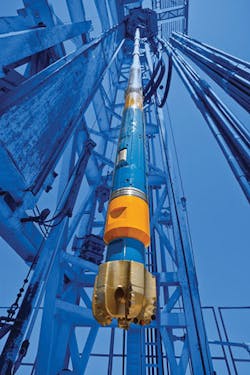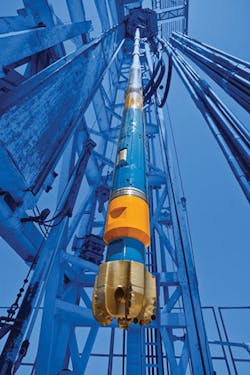Change in drilling strategy brings string of efficiency milestones to Troll
Leif Petter Holme
Baker Hughes
Groundbreaking drilling procedures and technologies have played a vital role in transformingNorway’s Troll field from a profitable oil-containing gas province into one of the North Sea’s largest oilfields. Among the most important technology that led to the success of the Troll oil development has been rotary steerable systems (RSS) with sensors near the bit. RSS technology has been a key enabler of precise placement of horizontal wells in thin reservoirs such as the oil-bearing ones in Troll. Advances in formation evaluation and drill bit technologies are now extending the value of RSS-enabled drilling to record-setting, single-bit runs that are significantly improving well efficiency and economics in the mature field.
To maintain maximum oil production and avoid any premature gas breakthrough or water coning, wells are drilled at a controlled trajectory within 1.5 ft (.45 m) above the oil/water contact (OWC). Any departure from this position reduces the maximum possible reservoir coverage. Over time, the relative location to the OWC has become increasingly important because extensive production from the field creates movement in the fluid contacts. During the past few years, the field strategy to cost-effectively achieve more contact with the reservoir has shifted from drilling multilaterals to drilling side tracks and extended-reach lateral sections from existing wells.
More recently, to improve time and cost savings, the focus has been on drilling to total depth (TD) in one bit run. Baker Hughes has adapted its drilling strategy for the field accordingly, through standardization of bottomhole assemblies (BHA) and processes, and the integration of a new line of Talon Force polycrystalline diamond compact (PDC) bits and cutters to withstand the dense calcite cementation within the thin sandstone oil columns. These changes have led to major improvements in well efficiency. Within the last two years, the integrated drilling systems have achieved longer, record-setting, single-bit runs the 15,000+-18,000+- ft (5,000+- to 6,000+-m) lateral distance range. The most recent run, completed in July 2016, was 19,960 ft (6,084) m.
Troll field background
Discovered in 1979, theTroll field covers some 290 sq mi (750 sq km) in the Norwegian North Sea and contains 60% of the total gas reserves on the Norwegian outer continental shelf. Reservoir specialists estimate the field’s gas will continue to be produced economically for at least 70 more years.
Considerable oil exists in the field, but the thin oil reservoirs – 72-85 ft (22-26 m) in the Troll West oil province and 36-43 ft (11-13 m the Troll West gas province) – were not economically viable for production in the early years of the field. Both oil reservoirs are located about 3,936 ft (1,200 m) below the seabed.
The Troll reservoir sands are in general made up of high-permeability C sand and lower-permeability M sand. A third lithological component is calcite-cemented sandstones. Calcite cement usually appears in isolated zones in the sandstone, acting as permeability barriers. The calcite-cemented sandstones may occur as discrete layers or nodules, layers of strata-bound concretions, scattered concretions, and more rarely, patchy calcite. Calcite-cemented layers typically have thicknesses from around 4 in. to 3 or 6 ft (10 cm to 1 or 2 m), and vary widely in lateral extent. The average calcite content of Troll oil reservoirs has been 7-10% annually between 2007 and 2015.
Troll oil drilling challenges
The complex geology of the Troll oil reservoirs present many challenges to drilling operations. Faulting and changes in the OWC create challenges to keeping the well centered to the OWC. Significant time spent drilling through abrasive sandstone can cause excessive wear on logging-while-drilling (LWD) tools, the BHA, and the bit. These issues are heightened by unpredictable zones of calcite cementation.
The most common Troll reservoir sands have a rock strength varying from 4,000 psi to 8,000 psi that easily could be drilled with instantaneous rates of penetration (ROP) on the order of 300 ft/hr (100 m/hr). On the other hand, the zones of calcite cementation vary in rock strength from 15,000 psi to more than 25,000 psi, which can compromise drilling performance to the point that ROP occasionally will be less than 6 ft/hr (2 m/hr). Geosteering in thin oil columns of sandstone interbedded with calcite cementation poses the risk of deflections, low ROP, stickslip, and vibrations.
Not only do the calcite stringers or nodules pose challenges to drilling performance, they also can significantly impact well placement. With a window of only .5 m above the well for 6,000-m (19,685-ft) lengths, sudden contrasts in formation hardness between porous sandstone and hard calcite can damage the bit. Additionally, the geometry of the calcite body in relation to the planned well path can cause deviation from the planned trajectory. In these instances, because of differing rock hardness, the drilling assembly follows the path of least resistance and creates an unwanted angular deflection, or high local dogleg.
Overcoming the challenges
Overcoming the drilling challenges in the Troll field’s complex oil reservoirs has been a function of continuous improvement of processes and procedures, BHAs, tools, fluids, and bits, and standardization whenever possible and beneficial. Proactive, strategic operational planning, cross-discipline collaboration, active use of drilling parameters during drilling, close communication between experienced and focused personnel – both offshore and in offices, after-action reviews and analyses, and sharing of lessons learned have been critical success factors.
The length of horizontal sections drilled with one bit run has increased, with new records being set by each successive run. The PERFFLOW LD water-based reservoir drill-in fluid (RDIF) is also setting records in these long horizontal sections, which are typically drilled with oil-based mud. A summary of the most recent records is presented in the associated table.
Single-bit runs
The following are short summaries of some of the single-bit runs.
Well 1. Objectives for this well, drilled in mid-2014, were to perform open-hole side track (OHST) after drilling 11,482 ft (3,500 m) on the first branch, then drill the second branch totaling more than 16,404 ft (5,000 m) horizontal in one bit/BHA run.
The BHA included a Talon high-efficiency PDC bit with EZCurve directional technology, integrated with the AutoTrak RSS and CoPilot measurement-while-drilling (MWD) system. Additionally, the company’s reservoir navigation services provided active geosteering with azimuthal LWD data.
The EZCurve directional technology maintained steerability and reduced vibrations to mitigate BHA tool failure. The RSS provided precise well control and trajectory, and left a clean hole for the completion system. The MWD system delivered real-time drilling optimization data to enhance drilling performance.
The operator drilled a field-record distance of 16,598 ft (5 059 m), including an open-hole side track, in a single run. ROP averaged 98.8 ft/hr (30.1 m/hr), 27% faster than the planned benchmark of 72.2 ft/hr (22.0 m/hr).
Well 2. The company set a new record in October 2015 by drilling a 16,900-ft (5148-m) section in a single bit run. Using essentially the same BHA as Well 1, the objective was to drill as efficiently and quickly as possible within safe limits to maintain wellbore and log quality.
Common procedure during drilling in the Troll reservoir has been to limit the maximum ROP to 60 m/hr. In this section, ROP was further limited in long intervals due to data density and hole cleaning. High torque was as expected toward the end of the section, almost reaching the limit for over-torquing the connections. Adding up to 2.5% lubricant to the mud reduced the friction between the hole wall and the drillstring, and between the casing and drillstring. This resulted in approximately 20% reduction in the surface torque measured on the top drive. Precise well control and trajectory were maintained, and ROP for the single run was 29.77 m/hr, as stipulated by the operator. Approximately a day of rig time was saved.
Well 3. A third drilling record for the Troll field was set in April 2016 with an 8½-in. section length of 17,356 ft (5,290 m) drilled in one run. The 6¾-in. BHA, which included the Talon Force PDC bit with StaySharp cutters, drilled the challenging horizontal reservoir section in 221 circulating hours through the calcite-cemented sandstone to a final TD of 25,005 ft (7,317 m). The new bit and cutter combination helped to improve drilling efficiency and overall performance.
Precise geological wellbore placement was provided by using the company’s VisiTrak real-time reservoir navigation and analysis service within the thin oil-bearing layer, and following a constant 1-2-m distance to the OWC. The service was selected because of its unique ability to provide a reservoir-scale view 360° around the borehole and to detect and map multiple bed boundaries and reservoir 100 ft away from the wellbore, in real time. The knowledge gained from this service, combined with the precise drilling capability of the RSS, helped maintain the control necessary to optimally place the wellbore close to the OWC while maintaining ROP. Seismic interpretation had indicated two possible areas where the reservoir roof was descending close to an unstable shale section. By mapping reservoir architecture to surface seismic data, the real-time reservoir navigation and analysis service showed that the roof was significantly farther from the wellbore than expected in these intervals. Without the service, ROP would have been reduced unnecessarily to avoid an inaccurate boundary.
Additional expected drilling challenges, such as drilling through faults and drillstring torque limitations, were handled successfully with only minor impact on the operation.
Well 4.The most recent Troll drilling record was set in July of this year, with a single bit run of 19,961 ft (6,084 m). The well team drilled a 19,960 ft (6,084 m) horizontal section comprised of 5.2% C-sand calcite in one run to section TD, with a total depth of 25,922 ft (7,901 m) —18% longer than the distance of well 2 and 15% longer than well 3. ROP was maintained at 22.9 m/hr. As planned for minimizing torque and drag, the well path was adjusted while drilling to reduce dogleg severity to below 3.0°/100 ft. Lubricants were added to the mud from the start of drilling to maintain low vibration and torque values. Vibration data was low throughout, with the little that was seen being formation-related.
The dramatic increase in distance drilled on this run is attributable to the company’s new Talon Force PDC bit that uses Stabilis reinforced cutters to extend bit life in Troll’s abrasive and impact-prone drilling environment. The cutter’s geometry adds a secondary bevel on the face of the cutter to increase its strength and protect against ROP-limiting chipping and spalling. This feature provides lower and more consistent torque response across changing depths of cuts to improve ROP and overall performance. The cutters can withstand a higher degree of wear and improve torsional stability in interbedded or directional applications.
The first of the new bits arrived in Norway in December 2015 and proved highly effective. The new Talon Force bits have not only set new performance benchmarks for the Troll field; they have been retrieved after drilling through calcites in extremely long sections showing very little wear. Plans are to integrate the new bit into the standard Troll BHA going forward to continue to improve efficiency and wellbore quality while increasing single-bit distances drilled.


